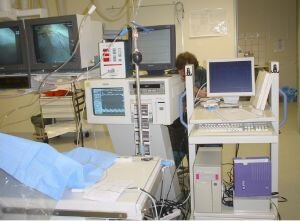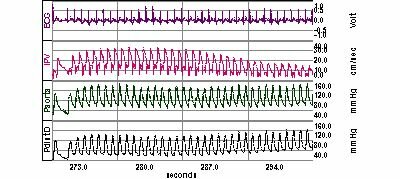
Aim: My project deals with the dynamic analysis of hemodynamic signals in the coronary circulation. The purpose of the project is to exploit the clinically obtainable signals of coronary pressure and flow velocity to evaluate the status of coronary artery disease and effects of treatment in epicardial arteries and the coronary microcirculation.
Background: Coronary blood flow is pulsatile and the results of the aortic pressure wave at the coronary inlet and squeezing of the microcirculation by cardiac contraction. Additionally, both mean flow, the variable important for oxygen supply, and pulsatile flow are determined by the dynamically varying resistance of the small arteries and arterioles in the coronary microcirculation. Coronary artery disease mostly affects the larger epicardial conduit vessels, which in turn has a deleterious effect on the downstream microvessels.
There is an increasing array of modalities to evaluate the coronary circulation. The classical approach is by x-ray imaging and subsequent quantitative analysis of the film. About 10 years ago, guide wires equipped with pressure or with Doppler flow sensors were introduced into the catheterization laboratory, allowing for assessment of coronary artery disease on the basis of physiological parameters. Our group has the unique possibility to simultaneously measure intracoronary pressure and flow velocity signals distal to stenoses in patients with a novel dual-sensor guide wire (Figures 1 and 2). With this tool, physiological assessment of both the stenosis severity and the status of the microcirculation are possible. This has already resulted in the evaluation of stenosis pressure drop-velocity curves and some observations on the coronary microcirculation in vivo, both before and after percutaneous coronary intervention (Siebes et al., Circulation 2004, 109: 756-762). However, a detailed analysis of the phasic components of these signals in has not yet been done.

Figure 1: Coronary x-ray image and hemodynamic data acquisition in the catheterization laboratory at the AMC.

Figure 2: Intracoronary signals distal to a stenosis in a patient. From top to bottom, ECG, flow velocity, aortic and distal pressure

A few words about myself: I was born in Kingston, Great Britain on August 2, 1976 and was raised in Athens, Greece. I studied Mechanical Engineering (1995-2000) at the National Technical University of Athens (NTUA), Department of Mechanical Engineering. After my undergraduate studies I worked as a research assistant (2000-2001) at the NTUA on the visualization and measurement of velocity fields around artificial heart valves, under the supervision of Professor S. Tsangaris. In 2001 I moved back to my land of birth and obtained my MSc degree in Engineering and Physical Science in Medicine (2001-2002) from the Imperial College of Science, Technology and Medicine, Department of Bioengineering. My Master’s Thesis entitled ‘Waves in Elastic Tubes: The Effect of Velocity’ was supervised by Professor K.H. Parker. In February 2003, I started my PhD at the University of Amsterdam, Department of Medical Physics, under the supervision of Dr. Maria Siebes and Prof. Jos Spaan.
![]()